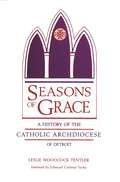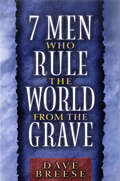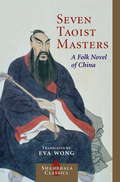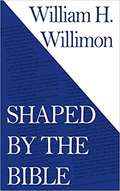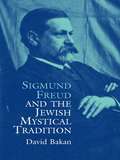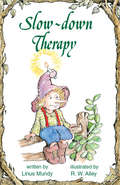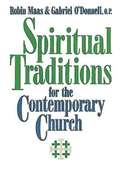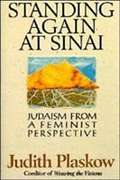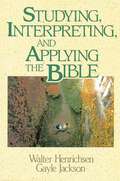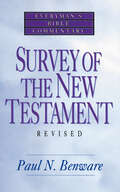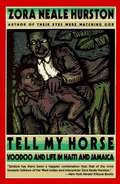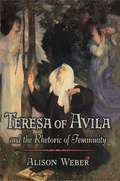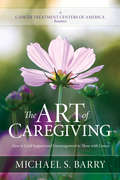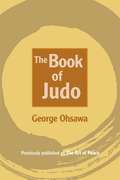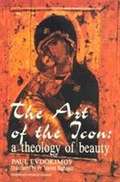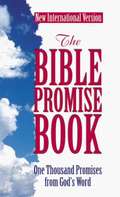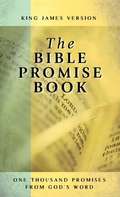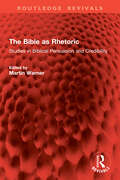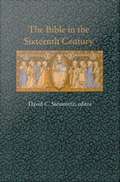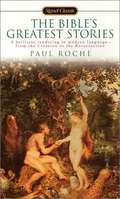- Table View
- List View
Seasons of Grace: A History of the Catholic Archdiocese of Detroit (Great Lakes Books Series)
by Leslie Woodcock Tentler Edmund Cardinal SzokaSeasons of Grace is a history of the Catholic Church and community in southern lower Michigan from the 1830s through the 1950s. More than a chronicle of clerical successions and institutional expansion, the book also examines those social and cultural influences that affected the development of the Catholic community. <P><P> To document the course of institutional growth in the diocese, Tentler devotes a portion of the book to tracing the evolution of administrative structures at the Chancery and the founding of parishes, parochial schools, and social welfare organizations. Substantial attention is also given to the social history of the Catholic community, reflected in changes in religious practice, parish life and governance, and the role of women in church organizations and in devotional activities. Tentler also discusses the issue of Catholics in state and local politics and Catholic practice with regard to abortion, contraception, and intermarriage.
Seven Men Who Rule the World From the Grave
by Dave BreeseThough their bodies lie cold and dormant, the grave cannot contain the influence these seven men have had on today's world. They continue to rule because they have altered the thinking of society. They generated philosophies that have been ardently grasped by masses of people but are erroneous and antiscriptural. Today these ideas pervade our schools, businesses, homes, and even the church. As we continue to unknowingly subscribe to their philosophies, we keep the grave open for Charles Darwin, Karl Marx, Julius Wellhausen, John Dewey, Sigmund Freud, John Maynard Keynes, and Soren Kierkegaard. Dave Breese warns us of the dangers of believing unreservedly the ideas of these seven men. He also reminds us of the only man whose life and words we can trust completely- Jesus Christ.
Seven Men Who Rule the World From the Grave
by Dave BreeseThough their bodies lie cold and dormant, the grave cannot contain the influence these seven men have had on today's world. They continue to rule because they have altered the thinking of society. They generated philosophies that have been ardently grasped by masses of people but are erroneous and antiscriptural. Today these ideas pervade our schools, businesses, homes, and even the church. As we continue to unknowingly subscribe to their philosophies, we keep the grave open for Charles Darwin, Karl Marx, Julius Wellhausen, John Dewey, Sigmund Freud, John Maynard Keynes, and Soren Kierkegaard. Dave Breese warns us of the dangers of believing unreservedly the ideas of these seven men. He also reminds us of the only man whose life and words we can trust completely- Jesus Christ.
Seven Taoist Masters: A Folk Novel of China
by Eva WongHistory and legend are interwoven in this folk novel that both entertains and instructs. Written by an unknown author, Seven Taoist Masters is the story of six men and one woman who overcome tremendous hardships on the journey to self-mastery. These characters and their teacher, Wang Ch'ung-yang, are all historical figures who lived in the Southern Sung (1127-1279) and Yuan (1271-1368) dynasties. Wang is regarded as the greatest patriarch of the Complete Reality school, a highly purified branch of Taoism having a strong affinity with Zen Buddhism. The novel brings to life the essentials of Taoist philosophy and practice, both through the instructions offered by Wang--on topics such as the cultivation of mind and body, meditation techniques, and overcoming the obstacles to enlightenment--and through the experiences of the characters.
Shaped by the Bible
by William H. WillimonWilliam H. Willimon's text about Biblical interpretation was originally published in 1991.
Sigmund Freud and the Jewish Mystical Tradition
by David BakanIn this pioneering work, David Bakan challenges the popular view of Freud as an entirely secular intellectual, schooled in modern culture rather than Jewish traditions. Bakan contends that the father of psychology was profoundly influenced by mystic lore about which he appeared to know very little -- and which represents the antithesis of scientific method.This work is based on the premise that Freudian psychoanalytic theory is largely rooted in the Jewish religion, particularly the mysticism of the kabbala. In a fascinating interpretation of the blend of personality and cultural history, Bakan explains how Freud's Jewish heritage contributed, either consciously or unconsciously, to his psychological theories. The author employs Freud's own distinction between being a Jew and the acceptance of Jewish doctrine to demonstrate the effect of Jewish mysticism in the formation of Freud's technical genius.With its focus on the ways in which Freud was and was not Jewish, this study offers a model example of the problem of Jewish identity -- as embodied by one of the giants of modern science, who professed to be both "infidel" and "Jew."
Sing to Me of Dreams
by Kathryn Lynn DavisIn the grand tradition of The Far Pavilions, The Thorn Birds, and Kathryn Lynn Davis's own magnificent New York Times bestseller, Too Deep for Tears, Sing to Me of Dreams is a rich, sensuous, deeply imagined novel filled with the intimate yearnings and passions of a turbulent family, their lovers and friends, and the extraordinary woman who entered their lives. There is a future I do not seek, but which will come to be, just the same....With these words echoing in her heart, Saylah, born of a white father and Indian mother, set off on a journey that would take her through all the mysteries of the human heart. As a child, she came to know the bounty of the earth and sea, the clear streams, and she guarded the secret wisdom of her close-knit Indian people. But when tragedy devastated her loved ones, Saylah was forced to leave her home and enter the world of the Ivys, an English-born family whose European traditions were as strange to her as her spirit world was to them. The Ivys had come to the lush, fertile Pacific Northwest in pursuit of a dream -- to build a paradise of prosperity and freedom. Until Saylah came to them, their dream had been denied. Julian Ivy had a dream of his own. An impatient young man in whom refinement and rage were intertwined, he was drawn to Saylah's healing power and disturbing beauty. Through heartbreak and joy, Julian and Saylah would discover the richness of love...but no one could resolve for her the conflicts of her heritage. Heeding the call of her destiny, she would finally make the most wrenching choice of all....
Slow-down Therapy
by R. W. Alley Linus MundySlow-down Therapy offers thirty-five concrete ideas for helping you rediscover something you already possess: time, enough time. This delightful book will guide you to a more peaceful, relaxed use of time--and help you celebrate the priceless prize time gives, the priceless prize called life. \
Song of the Brook
by Matilda NordtvedtIn this fascinating sequel to Secret in the Maple Tree we follow Hilda and her family from their home on a Minnesota farm to a country place near Bellingham, Washington. Hilda becomes envious of the grandeur of their relatives' home and life style until she realizes how satisfying her simple joys are: listening to the brook, talking to God by her window, exploring the woods with John, and doing something original for the closing program at school.
Spiritual Traditions for the Contemporary Church
by Robin Maas Gabriel O'DonnellPart I, "The Roots of Contemporary Western Spirituality," covers spiritual types that have been fundamental in shaping spiritual practice. Part II, "Distinctive Spiritual Traditions," offers major introductory essays on spiritual traditions formed by such notable figures as Luther, Wesley, Ignatius, and John of the Cross, as well as ecclesiastical traditions such as Anglicanism. Part III, "The Feminine Dimension in Christian Spirituality," is devoted to Marian Spirituality; Holy Women: Their Spiritual Influence in the Middle Ages; and Feminism and Spirituality. Each of the fourteen chapters is followed by a practicum which enables readers to assimilate into their own devotional life the practice prescribed.
Spiritual Traditions for the Contemporary Church
by Gabriel Odonnell Robin M. MaasThis volume offers a comprehensive intellectual and experiential introduction to Christian spirituality. It embraces spiritual traditions from the Patristic period to the present day. Part I, "The Roots of Contemporary Western Spirituality," covers spiritual types that have been fundamental in shaping spiritual practice. Part II, "Distinctive Spiritual Traditions," offers major introductory essays on spiritual traditions formed by such notable figures as Luther, Wesley, Ignatius, and John of the Cross, as well as ecclesiastical traditions such as Anglicanism. Part III, "The Feminine Dimension in Christian Spirituality," is devoted to Marian Spirituality, holy women, and feminism. Each of the fourteen chapters is followed by a practicum which enables readers to assimilate the practice prescribed into their own devotional life .
Standing Again at Sinai: Judaism from a Feminist Perspective
by Judith PlaskowFeminist critique of traditional Jewish attitudes toward women that engages with biblical and other traditional texts which have been used to support male domination, and reinterprets them from a feminist perspective.
Studying, Interpreting, and Applying the Bible
by Gayle Jackson Walter A. HenrichsenStudying, Interpreting, and Applying the Bible combines into one volume the popular trilogy by Walter Henrichsen and Gayle Jackson: - A Layman's Guide to Studying the Bible - A Layman's Guide to Interpreting the Bible - A Layman's Guide to Applying the Bible This book will help students as well as ministers, young people and old alike, as they learn to study Scripture more easily and conveniently. The chapters on studying the Bible help the beginning or experienced Bible student mine God's Word for its riches through verse analysis, chapter analysis, the overview of a book, the study of a topic, and the study of Bible characters (including charts, diagrams, and other helpful illustrations). The unit on interpreting the Bible explains Bible interpretation based on grammar, history, and theology. The section on applying the Bible moves beyond study to life applications, enabling a person to - be motivated to make personal application - move beyond a "to do" list to an internal desire to obey - consider the risks involved in obeying - use specific application principles
Survey of the New Testament- Everyman's Bible Commentary (Everyman's Bible Commentaries)
by Paul BenwareThe New Testament is worthy of a lifetime of study, as it answers the most significant questions people have asked,' says Paul Benware. What is the purpose of life? Is there any real hope? What is God like? Can I be freed from guilt and sin?Jesus Christ is the only answer to those questions. He is the key to God's New Covenant, the central theme of the New Testament.In order to fully appreciate the New Covenant, you must explore the lives and times of Christ and the New Testament writers. Survey of the New Testament organizes this essential information around the anticipation, institution, and fulfillment of the New Covenant. Dr. Benware, along with his book-by-book study of the 27 New Testament books, includes a chronological study of the life of Christ, a look at political forces and ideologies of the first-century Roman world, and a glimpse into the inter-testamental period. To clarify the order and pattern of the New Testament, Dr. Benware links each epistle to its historical base, the book of Acts. Thirty helpful charts have been included as well.
Survey of the New Testament- Everyman's Bible Commentary (Everyman's Bible Commentaries)
by Paul BenwareThe New Testament is worthy of a lifetime of study, as it answers the most significant questions people have asked,' says Paul Benware. What is the purpose of life? Is there any real hope? What is God like? Can I be freed from guilt and sin?Jesus Christ is the only answer to those questions. He is the key to God's New Covenant, the central theme of the New Testament.In order to fully appreciate the New Covenant, you must explore the lives and times of Christ and the New Testament writers. Survey of the New Testament organizes this essential information around the anticipation, institution, and fulfillment of the New Covenant. Dr. Benware, along with his book-by-book study of the 27 New Testament books, includes a chronological study of the life of Christ, a look at political forces and ideologies of the first-century Roman world, and a glimpse into the inter-testamental period. To clarify the order and pattern of the New Testament, Dr. Benware links each epistle to its historical base, the book of Acts. Thirty helpful charts have been included as well.
Tell My Horse: Voodoo and Life in Haiti and Jamaica
by Zora Neale HurstonAs a first-hand account of the weird mysteries and horrors of voodoo, Tell My Horse is an invaluable resource and fascinating guide. Based on Zora Neale Hurston's personal experiences in Haiti and Jamaica, where she participated as an initiate rather than just an observer of voodoo practices during her visits in the 1930s, this travelogue into a dark world paints a vividly authentic picture of ceremonies and customs and superstitions of great cultural interest.
Teresa of Avila and the Rhetoric of Femininity
by Alison WeberCelebrated as a visionary chronicler of spirituality, Teresa of Avila (1515-1582) suffered persecution by the Counter-Reformation clergy in Spain, who denounced her for her "diabolical illusions" and "dangerous propaganda." Confronting the historical irony of Teresa's transformation from a figure of questionable orthodoxy to a national saint, Alison Weber shows how this teacher and reformer used exceptional rhetorical skills to defend her ideas at a time when women were denied participation in theological discourse. In a close examination of Teresa's major writings, Weber correlates the stylistic techniques of humility, irony, obfuscation, and humor with social variables such as the marginalized status of pietistic groups and demonstrates how Teresa strategically adopted linguistic features associated with women--affectivity, spontaneity, colloquialism--in order to gain access to the realm of power associated with men.
The Art of Caregiving
by Michael S. BarryWritten to encourage the caregiver, The Art of Caregiving will be a candle of joyful hope to the one whose life has taken on unique new challenges when a loved one faces cancer.Cancer treatment is often a nighttime journey through a wilderness, during which patients and their caregivers are confronted with worry and fear; a journey where the slightest flicker of hope means more than words can express.Michael S. Barry shows how, with God's help, you can be the light of hope for those who bear the burden of illness.
The Art of Peace
by William Gleason George OhsawaOhsawa relates judo and aikido to the establishment of world peace.
The Art of the Icon: A theology of beauty
by Paul EvdokimovBeauty, The Sacred, The Theology of the Icon, A Theology of Vision.
The Bible Promise Book
by The Editors at Barbour PublishingWhatever the need of the moment, the answer is to be found in Scripture, if we take the time to search for it.
The Bible Promise Book: King James Version
by Barbour PublishingGOD'S PROMISES One of life's tew absolutes. Compared to death and taxes, God's promises certainly sound good. But these eternal words of comfort, love, hope, and peace are better than good. They're the best news of life. Millions of seekers around the world have discovered the treasures of The Bible Promise Book. Millions have embraced God's promises and not been disappointed. Arranged in alphabetical order according to subject, this remarkable little book can be described in two words. Absolute necessity.
The Bible as Rhetoric: Studies in Biblical Persuasion and Credibility (Routledge Revivals)
by Martin WarnerFirst Published in 1990, The Bible as Rhetoric explores the ways in which the persuasive strategies employed in the biblical texts relate (both positively and negatively) to their preoccupations with religious and historical truth. The book contains pioneering interdisciplinary papers that clarify what is at issue in the apparently competing claims that the Bible should be read ‘as literature’ and ‘as scripture’.Uniquely, the volume brings together philosophers, literary critics, biblical scholars, theologians, and historians of ideas who combine the best biblical and historical scholarship with a range of contemporary approaches to the study of texts, from the deconstructive and the feminist through the Wittgensteinian to those of the heirs of the tradition of practical criticism. The volume is of importance both to those interested in the applications of contemporary literary theory and to all those concerned with the relation between religious and secular readings of the Bible.
The Bible in the Sixteenth Century
by David С. SteinmetzA distinguished group of authors here illuminate a broad spectrum of themes in the history of biblical interpretation. Originally published in 1990, these essays take as their common ground the thesis that the intellectual and religious life of the sixteenth century cannot be understood without attention to the preoccupation of sixteenth-century humanists and theologians with the interpretation of the Bible. Topics explored include Jewish exegesis and problems of Old Testament interpretation and the relationship between the Bible and social, political, and institutional history. Contributors. Irena Backus, Guy Bedouelle, Kalman P. Bland, Kenneth G. Hagen, Scott H. Hagen, Scott H. Hendrix, R. Gerald Hobbs, Jean-Claude Margolin, H. C. Erik Midelfort, Richard A. Muller, John B. Payne, David C. Steinmetz
The Bible's Greatest Stories
by Paul RocheFrom the awe-inspiring story of the Creation to the defeats and triumphs of the Children of Israel and the life, death, and Resurrection of Jesus, here are the greatest accounts from the greatest book ever written, presented in an accessible form for contemporary readers. Enhanced with annotations, Paul Roche's brilliant retelling of these stories is at once impeccably accurate and vibrantly told. He brings to life the saga of Joseph and the coat of many colors, the drama of the fall of Jericho, the heroism of a young David fighting Goliath and the lust of an older David for Bathsheba, the glory and wisdom of Solomon, the bravery of Judith, the dark despair of Job, the faith of Daniel in the lion's den, the joy of the Nativity, and the miracle of the Resurrection. These are just a few of the many great biblical stories presented in this masterful translation by a distinguished poet and scholar.
